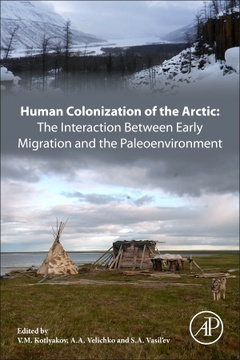Description
Human Colonization of the Arctic: The Interaction Between Early Migration and the Paleoenvironment
Coordinators: Kotlyakov V.M., Velichko A. A., Vasil'ev S. A.
Language: English
Keywords
Adaptations; Agriculture; Alaska; Ancient DNA; Animal procurement; Anthropogenic influence on the landscape; Anthropology; Archeological culture; Arctic regions; Arctic; Atlantic; Bering Land Bridge; Beringia; Birch forest; Ceramic Neolithic; Chronostratigraphy; Craniology; Culture; East Eurasia; East Europe; Eastern Europe; Eastern Siberia; Environmental change; Environments; Fauna; Fennoscandia; Fishing; Flora; Fosna; Gene geography; Gene pool; Genetic adaptation; Glaciers; Greenland; Habitations; High latitudes; Holocene; Hominids; Human dispersals; Human expansion; Hunter-gatherers; Hunters; Hunting; Ice sheets; Initial colonization; Inuit; Karginsky; Kola Peninsula; Komsa; Landscape and environment dynamics; Late glacial maximum; Late Paleolithic; Late Pleistocene; Lifestyle; Marine terraces; Marine transgressions; Mesolithic; Middle Paleolithic; Migration; Migrations; Musk oxen; Natural resources; Neanderthals; Neolithic; Northeastern Europe; Northern Eurasia; Northern Norway; Novaya Zemlya; Osteology; Paleoanthropology; Paleoclimates; Paleodiets; Paleoeskimo; Paleoindian; Peopling; Pine forest; Pleistocene; Polar circle; Preboreal; Prehistoric people; Quartz industry; Refugia; Sartan; Seafaring; Settlement; Settlements; Siberia; Spitsbergen; Stable isotopes; Stone tools; Subsistence behavior; Taimyr; The Kunda-Butovo technocomplex; The Urals; Toolkit; Tundra; Tundra-steppe; Upper Paleolithic; Urals; Valday; West Eurasia; West Siberia; Western Hemisphere; Whales
Support: Print on demand
Description
/li>Contents
/li>Readership
/li>Biography
/li>Comment
/li>
Human Colonization of the Arctic: The Interaction Between Early Migration and the Paleoenvironment explores the relationship between humans and the environment during this early time of colonization, utilizing analytical methods from both the social and natural sciences to develop a unique, interdisciplinary approach that gives the reader a much broader understanding of the interrelationship between humanity and the environment. As colonization of the polar region was intermittent and irregular, based on how early humans interacted with the land, this book provides a glance into how humans developed new ways to make the region more habitable.
The book applies not only to the physical continents, but also the arctic waters. This is how humans succeeded in crossing the Bering Strait and water area between Canadian Arctic Islands. About 4500 years ago , humans reached the northern extremity of Greenland and were able to live through the months of polar nights by both adapting to, and making, changes in their environment.
PART 1 REGIONS OF INITIAL COLONIZATION 1. European North 2. Siberian North 3. Beringia (North-East of Asia, Alaska, Yukon) 4. Canadian North, Greenland, Iceland 5. Greenland 6. Iceland
PART 2 SPECIFIC FEATURES OF THE INITIAL COLONIZATION 7. Expansion of the oecumene northwards and paleodiet tradition on the Paleolithic humans in Eurasia: Neanderthals and Modern Humans 8. Mesolithic population in the north of Eastern Europe 9. Way to North: anthropological evidence of adaptive abilities of the first inhabitants in the High Latitudes 10. Genetic data on the colonization of the High Latitudes 11. Stages of initial human colonization of Arctic and Subarctic
Arctic specialists, climate scientists, biologists, ecologists, paleogeographers, archeologists, anthropologists, ethnographers, geologists
The late Dr Velichko was one of top specialists in paleogeography, known for his works on the history of Man and Nature interaction. He was the first chair and founded he IGU Commission for Environment Evolution. At the time of his death he was the head of the Laboratory of Evolutionary Geography, within the Institute of Geography of the Academy of Sciences. He was renowned for his work in Late Cenozoic paleoclimatology and paleoecology of Early Man, as well as his expertise in the analysis of the environment and climate evolution.
Dr Vasil’ev is a Professor with the Institute for the History of Material Culture at the Russian Academy of Sciences. He is a foremost archeologist whose studies are centered on the Early Man colonization of the middle and high latitudes of the Northern Hemisphere.
- Written by pioneering experts who understand the relationship between humans and the environment in the arctic
- Addresses why the patterns of colonization were so irregular
- Includes coverage of the earliest examples of humans, developing an understanding of ecosystem services for economic development in extreme climates
- Covers both terrestrial and aquatic ecosystems




